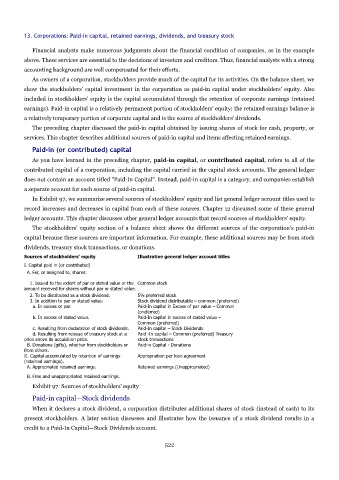Page 521 - Accounting Principles (A Business Perspective)
P. 521
13. Corporations: Paid-in capital, retained earnings, dividends, and treasury stock
Financial analysts make numerous judgments about the financial condition of companies, as in the example
above. These services are essential to the decisions of investors and creditors. Thus, financial analysts with a strong
accounting background are well compensated for their efforts.
As owners of a corporation, stockholders provide much of the capital for its activities. On the balance sheet, we
show the stockholders' capital investment in the corporation as paid-in capital under stockholders' equity. Also
included in stockholders' equity is the capital accumulated through the retention of corporate earnings (retained
earnings). Paid-in capital is a relatively permanent portion of stockholders' equity; the retained earnings balance is
a relatively temporary portion of corporate capital and is the source of stockholders' dividends.
The preceding chapter discussed the paid-in capital obtained by issuing shares of stock for cash, property, or
services. This chapter describes additional sources of paid-in capital and items affecting retained earnings.
Paid-in (or contributed) capital
As you have learned in the preceding chapter, paid-in capital, or contributed capital, refers to all of the
contributed capital of a corporation, including the capital carried in the capital stock accounts. The general ledger
does not contain an account titled "Paid-In Capital". Instead, paid-in capital is a category, and companies establish
a separate account for each source of paid-in capital.
In Exhibit 97, we summarize several sources of stockholders' equity and list general ledger account titles used to
record increases and decreases in capital from each of these sources. Chapter 12 discussed some of these general
ledger accounts. This chapter discusses other general ledger accounts that record sources of stockholders' equity.
The stockholders' equity section of a balance sheet shows the different sources of the corporation's paid-in
capital because these sources are important information. For example, these additional sources may be from stock
dividends, treasury stock transactions, or donations.
Sources of stockholders' equity Illustrative general ledger account titles
I. Capital paid in (or contributed)
A. For, or assigned to, shares:
1. Issued to the extent of par or stated value or the Common stock
amount received for shares without par or stated value.
2. To be distributed as a stock dividend. 5% preferred stock
3. In addition to par or stated value: Stock dividend distributable – common (preferred)
a. In excess or par. Paid-In capital in Excess of par value – Common
(preferred)
b. In excess of stated value. Paid-In capital in excess of stated value –
Common (preferred)
c. Resulting from declaration of stock dividends. Paid-In capital – Stock Dividends
d. Resulting from reissue of treasury stock at a Paid -In capital – Common (preferred) Treasury
price above its acquisition price. stock transactions
B. Donations (gifts), whether from stockholders or Paid-in Capital - Donations
from others.
II. Capital accumulated by retention of earnings Appropriation per loan agreement
(retained earnings).
A. Appropriated retained earnings. Retained earnings (Unappropriated)
B. Free and unappropriated retained earnings.
Exhibit 97: Sources of stockholders' equity
Paid-in capital—Stock dividends
When it declares a stock dividend, a corporation distributes additional shares of stock (instead of cash) to its
present stockholders. A later section discusses and illustrates how the issuance of a stock dividend results in a
credit to a Paid-In Capital—Stock Dividends account.
522

